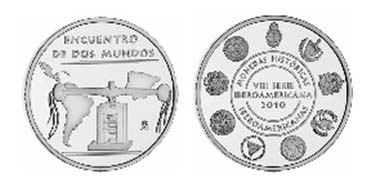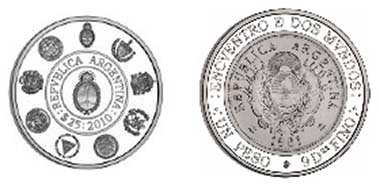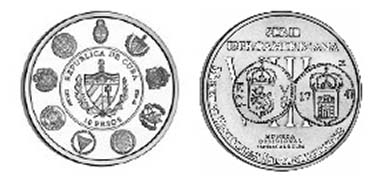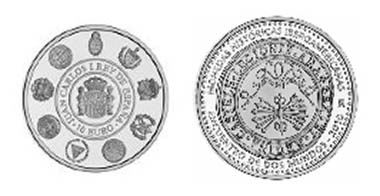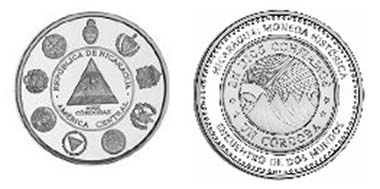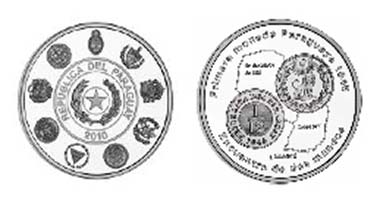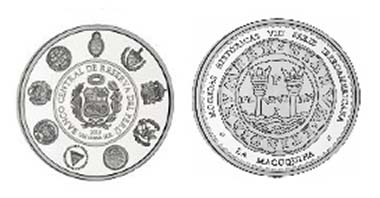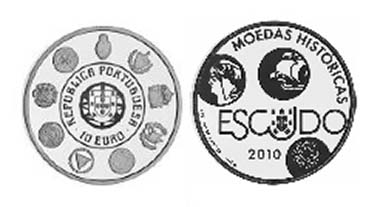September 8, 2011 – The 8th Set in the Ibero-American Series “A Meeting of Two Worlds” is composed of nine silver coins and a silver medal featuring the coats-of-arms of the nine countries participating in this issue (Argentina, Cuba, Spain, Guatemala, Mexico, Nicaragua, Paraguay, Peru and Portugal).
The silver medal.
Subject matter and specifications in common
The common subject matter for this issue is “Historic Ibero-American Coins” and the exceptional fact that each country has allowed the obverse of its own coin to display the arms of the other participating countries. The mint run will be a maximum of 12,000 sets. As with the preceding seven series, these nine coins will have the same specifications as the piece-of-eight and are minted in proof quality.
The Reverses
The center of the reverse side features in each case the Arms of the issuing country. Shown surrounding this central motif, and in alphabetical order clockwise, are the national coats-of-arms of the other countries that are participating in this issue.
Argentina’s coin. The obverse is a replica of the country’s first 1-Peso coin minted in silver after 1881.
The Obverses
Argentina
Reproduces a replica of the obverse of the country’s first 1-Peso coin minted in silver after 1881. This coin was popularly known as the patacon, the colloquial term used to designate colonial Spanish-American coins of similar characteristics.
Cuba’s coin is a reproduction of a coin minted during the siege of Santiago de Cuba in 1741.
Cuba
Reproduces a coin minted during the siege by the British of the city of Santiago de Cuba from July 29 to December 19, 1741. The coin issue was decided upon by the City Council and the city’s Governor.
Spain choose an 8-reales for representation in this project.
Spain
Reproduces the reverse of an 8-reales coin that was struck in Seville under the Catholic Monarchs Isabella I and Ferdinand V of Castile. The mint mark, assayer’s mark and face value were stamped on the obverse. So the symbols of the yoke and the arrows also appear on all the coins from 1 to 8 reales that were struck by any of the mints under these monarchs.
A replica of the first orbicular or circular coin that was minted in Guatemala after 1754.
Guatemala
Reproduces the first orbicular or circular coin that was minted in Guatemala after 1754. It is a silver coin of the “pillar” design type. The inclusion of the letter “G” identifies the Guatemalan mint. This design was utilized by different American mints during the same period of time.
Mexico’s 1-Peso struck in 1910 as replica.
Mexico
Reproduces the obverse and the reverse of the 1-Peso coins commonly called pesos del caballito and struck in 1910 during the decline of the Porfirio Diaz dictatorship. The obverse displays the country’s coat-of-arms charged with a spirited Mexican eagle, facing front with wings outspread. The reverse depicts an equestrian figure of Liberty.
This coin reproduces Nicaragua’s first coins minted in the cordoba currency in 1912.
Nicaragua
Reproduces the reverse of the first coins minted in the cordoba currency, created in March 1912 to replace the Peso. It shows the face of a rising sun radiating over a range of five volcanoes that represent the five Central American countries. This design has its origin in the metal 1-real coin which was struck in 1824 by the Central American Federation three years after the Central American countries had gained independence from Spain.
The cobrecito de leon stands for Paraguay.
Paraguay
Reproduces a coin known by the name of cobrecito de leon, an allusion to its slight worth. These coins were minted in the city of Birmingham (England). They were released into circulation by a decree dated March 1847 and they circulated until 1877. Twelve copper coins represented one real; eight reales made up one peso.
This reproduces the reverse of the first coin struck at the Mint of Lima in 1568.
Perù
Reproduces the reverse of the first coin struck at the Mint of Lima in 1568. These coins featured the two Pillars of Hercules surmounted by crowns, standing on ocean waves, with the legend “PLUS ULTRA” that had been the imperial motto of Carlos V in reference to the scope of Spain’s power overseas. Also shown is a letter “P” indicating Peru as the place of minting.
Portugal’s Escudo replaced the 1000-reales in the new Republic.
Portugal
Dedicated to the Escudo, the currency that replaced the 1000-reales by the Decree of May 22, 1911, after the establishment of the Republic. The design, in deference to the fact that the escudo still very much abides in the sentiment of the Portuguese public, utilizes the visual space of the coin to trace a trip back through time and through memory.
For more information on this series and other products of the Spanish Royal Mint, visit its website.
If you are interested in the intriguing story of the Spanish pieces of eight, take a look at the BBC project “A History of the World in 100 Objects”. You will find pictures, lots of information and a radio programme here.




